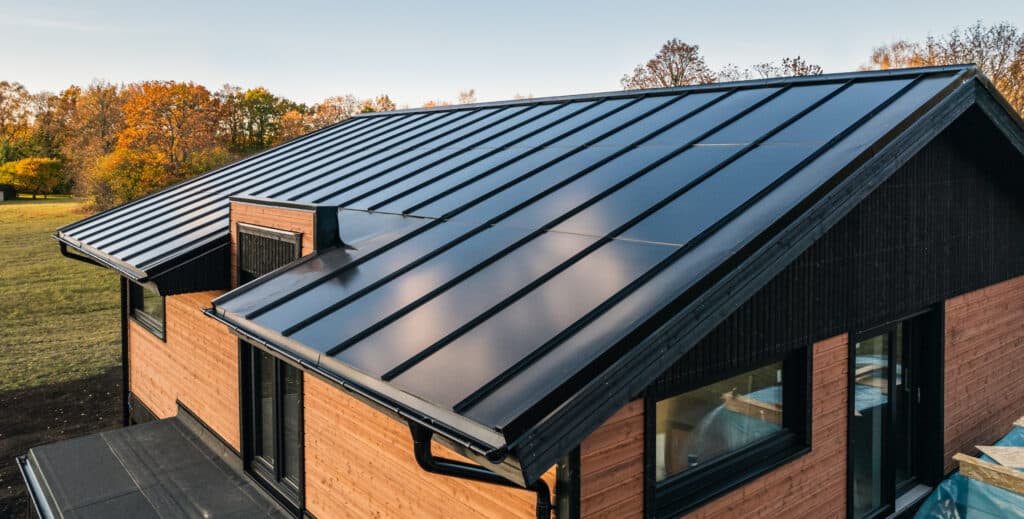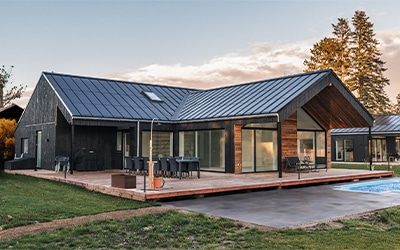What Affects the Cost & Why Homeowners Choose Them
Choosing a new solar system for your home is no longer just about generating electricity. More and more UK homeowners want their homes to look modern, sleek, and future-ready – without the bulky appearance of traditional panels. That’s where solar roof panels come in. Instead of sitting on top of your tiles or slates, these systems completely replace part of your roof covering, creating a flush, architectural finish that looks like the house designed it from day one.
If you’ve looked into options like Roofit Solar or other premium integrated systems, you’ll already know that this style of solar roofing has quickly become the go-to choice for homeowners who value both aesthetics and long-term performance. But one question always comes up: what affects the cost of roof-integrated solar panels in the UK? Because every home is different – different roof shapes, materials, pitches, ages – understanding what really goes into the cost is far more useful than a generic price tag.
This guide walks you through how integrated systems work, what influences the price, and why more people across the solar roof UK market are choosing this sleek, durable, and future-proofed alternative to solar energy.
What Makes Solar Roof Panels Different?

Traditional solar panels sit on top of your existing roof tiles using a mounting system with brackets and rails. They’re functional, of course, but they change the appearance of your home quite dramatically. They also leave your original roof covering underneath, which means two layers, more materials, and more visual bulk.
With solar roof panels, the panels are the roof. They act as your weatherproof covering while generating your electricity. This gives you a beautifully clean, flat surface with no visible brackets, rails, or mounting hardware. The roofing system itself integrates everything, a true blend of roofing and solar rather than two separate installations.
For many homeowners, especially those replacing an old roof or undertaking a renovation, this approach is a major upgrade. Roofit Solar systems like the one we install at Smartly Energy slot into the roof structure seamlessly, giving you a modern, uniform finish that looks a world away from the traditional bolt-on approach to solar panel roofing.
It also makes a noticeable difference to durability. Because the panels sit within the roofline rather than on top of it, they’re naturally more resistant to wind uplift and harsh weather – a real benefit given the UK’s storms, coastal winds, and unpredictable climate.
Why UK Homeowners Are Choosing Integrated Solar Roofing
One of the biggest reasons homeowners choose integrated solar roof panels is simply aesthetics. If you love the idea of renewable energy but dislike the look of framed panels bolted to your roof, integrated systems are a breath of fresh air. The surface appears clean, modern, and intentional – more like a contemporary metal roof than a solar array.
But it’s not just because they’re aesthetically pleasing. Integrated solar panel installations add an element of architectural quality. Many people see them as an upgrade to the home itself, not just the energy system. That means, if you ever choose to sell, buyers see a home that’s not only efficient, but also stylish and sustainable, something the solar roof UK market is leaning into more and more.
A well-installed integrated roof can even enhance your home’s value by improving its kerb appeal and future-proofing it for decades to come. And because the solar modules replace the roof covering, you’re getting both a premium roof and a renewable energy system in one installation.
What Affects Roof Integrated Solar Panels UK Cost?
Because every home is different, there’s no universal price for integrated systems. Instead of chasing a one-size-fits-all figure, it’s far more useful to understand the factors that influence roof integrated solar panels UK cost, as these are what shape your bespoke quote.
Your roof type is often the biggest variable. Slate roofs usually require more time and precision, while standard tile roofs are simpler to work with. New builds tend to be the most efficient because builders can incorporate the system into the structure from the outset. And if you’re already replacing your roof, an integrated system can be extremely cost-effective because you’re combining a reroof with a solar upgrade in a single project.
System size also plays a key role. A larger area of solar roof panels requires more materials and labour but will typically generate more electricity and offer stronger long-term value. The shape, pitch, and usable surface of your roof all determine how much solar roofing you can install.
Retrofits – installing solar panel roofing on an existing roof – may involve removing old materials or correcting structural issues. In contrast, new builds and full reroofs give installers a clean slate, which usually streamlines the process.
Beyond the roof itself, your electrical setup, inverter type, optional battery storage, and site access influence costs. Homes in tight streets, on steep pitches, or with limited working space often require more preparation and scaffolding.
Planning permission considerations can also affect the process. Most homes fall under permitted development, but listed buildings and conservation areas may need approval. The UK Government Planning Portal provides useful guidance if you’re unsure about your area.
Key Factors Influencing Cost
- Roof type (slate, tile, metal, new build, retrofit)
- Size and layout of your solar roof panels
- Structural work or roof replacement needs
- Electrical components and optional battery storage
- Access, scaffolding, and installation complexity
- Planning requirements depending on your location
Are Solar Roof Panels Better Value Than Traditional Systems?
While traditional panels have a lower entry cost, integrated solar panel roofing offers a different type of value. With traditional installations, you still have the original tiles underneath, which means two separate layers performing two different jobs. Integrated systems combine those jobs into one.
They give your home a premium, modern look, provide exceptional weatherproofing, and act as a long-term roof covering. For many households, this adds more lifetime value than saving a bit on the upfront cost of traditional panels. If you were considering replacing your roof anyway, choosing solar roofing can be a smart financial decision because you reduce waste, avoid re-roofing twice, and enjoy a future-proofed system from day one.
Is an Integrated Solar Roof the Right Choice for Your Home?
An integrated roof is a fantastic solution for several common homeowner situations. If you’re building a new home, it’s one of the cleanest, most modern ways to incorporate renewable energy. If you’re replacing an old roof, combining the reroof with a solar installation can be extremely cost-effective. And if you simply want your home to look sleek and contemporary, this is easily the most attractive solution.
That said, it isn’t right for everyone. Extremely tight budgets, very small roofs, or heavily shaded properties may find more value in a straightforward panel system. Integrated systems are best suited to homeowners who want a long-term, aesthetic, durable upgrade that becomes part of the home, not just something added on top.
What to Expect During Installation
The process usually starts with a survey to assess your roof’s structure, condition, and electrical setup. This is where your bespoke design begins. Once the design finalises, the installation team prepares the roof, removes any old materials if needed, and begins fitting the integrated modules into place.
Because the solar roof panels serve as your roof covering, you will find the installation more involved than a standard bolt-on system, but the result gives you a roof that looks refined, performs efficiently, and lasts. Once everything is in place, the team commissions the electrical system, sets up monitoring, and shows you how to track your energy production in real time.
How to Get a Bespoke Quote
Because every home is different, your next step is simply to book a survey. We’ll assess your roof, design a tailored solution, and guide you through what integrated solar roofing could look like on your home.
You can explore more about our partners for solar roof panels, Roofit Solar here.


